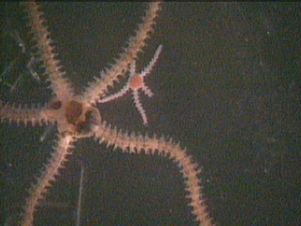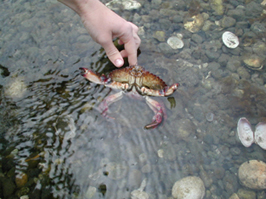
Numerous environmental and biological elements threaten
the existence of organisms at Argyle Creek. Among the most important
are water velocity, turbulence, desiccation, competition, and predation.
Below we discuss three major areas involving protection against these elements:
camouflage, species distributions, and specialized defense structures.
CAMOUFLAGE
Camouflage is the use of coloration, texture, and ornamentation
to blend into an environmental background. As shown in the picture
below, many of the species inhabiting the cobbled benthos at Argyle seem
to be camouflaged against the variable-sediment background.

The sediments comprising the stream bed at Argyle are
glacial in origin and are thus extremely variable in color, shape, and
size. The dominant colors of these rocks are brown, black, white,
green, pink, and red. The coloration of many of the organisms living
on this substrate mimic the colors of the rocks. For example, the
chitons are mostly black and brown, with a few green and red species.
Limpets display a variety of colors and patterns such as white with brown
speckles, white with black stripes, and cream with brown rings. The
small crabs living amongst the pebbles and cobbles on the stream bed are
dominantly deep red, green, and brown. Because these colors
are so similar to the colors of the rocks, this coloration provides good
protection from predators. For a more extreme and amusing example
of camouflage, see information about the Decorator
crab.
SPECIES DISTRIBUTION
Environmental factors limit the distributions of many species that live in Argyle Creek. Some organisms, such as sponges, bryozoans, anemones, serpulid worms and spirorbid worms, cannot withstand the long periods of exposure that occur along the edges of the creek at low tide. Thus, these organisms are restricted to portions of the creek that are continuously submerged throughout the tidal cycle. Crabs are more resistant to exposure and can be found on the banks of the creek.
Predation pressures also affect the distribution of species at Argyle. The large crabs, Cancer productus and C. Magister, were only found in Zone 1 where a large algal canopy (especially Ulva fenestrata) hovers above the substrate. The association of Cancer with Zone 1 may involve some measure of protection underneath this algal canopy.
A somewhat surprising pattern identified throughout the study area was the higher diversity and abundance of sessile suspension feeders on the lower, or cryptofaunal , surfaces of rocks as opposed to the upper, or epifaunal, surfaces. Before surveying the creek, we hypothesized that sessile suspension feeders would preferentially inhabit upper surfaces in order to gain better access to water currents that carry food particles. Our expectation was supported for some organisms, like well-protected barnacles, but not for others, like sea anemones. The velocity and turbulence over the exposed surfaces may, in fact, be too strong for some animals to effectively pull suspended particles out of the water column. By inhabiting more cryptic environments, the organisms are subjected to reduced flow velocity and turbulence. Cryptic environments may also, however, provide better protection from potential predators than do epifaunal environments. For example, Jackson (1983, p.70) claimed that algal grazing by chitons, presumably on the sun-exposed upper surfaces of rocks, may be incidentally disastrous for newly settled barnacles. Interestingly, the small barnacle Balanus is far more abundant in cryptic environments, while large chitons are much more abundant on the upper surfaces (although small 1 - 2 cm chitons and limpets appeared to be equally abundant on both sides of the rocks). It is most likely that the distribution of species is not only due to defense strategies, but is also a function of larval settling mechanisms and feeding strategies.
Burrowing is another defense strategy exploited by organisms at Argyle. Clams are abundant in the sandy mud lying below the gravel that lines the stream bed. This infaunal habitat protects these organisms from potential predators such as starfish and crabs. A wide variety of polychaete worms live within the sediments as well. Worms in the families Glyceridae, Orbiniidae, Terebellidae, Lumbrineridae, and Hesionidae were all fairly abundant within the fine grained sediments. More information about the importance of burrowing as a protective mechanism can be found at False Bay.
SPECIALIZED DEFENSE STRUCTURES
Many of the organisms inhabiting Argyle Creek have specialized structures that protect the organisms from environmental disturbances and predation. One such defense is the secretion of a calcium carbonate shell. A variety of molluscs living in the stream bear different types of shells. Mussels (Mytilus edulis), oysters (Crassostrea gigas), and various clams all possess bivalve shells that enclose and protect the body. Chitons possess a multi-plate shell and a muscular foot, which holds them firmly on the substrate. When the chiton feels threatened it can roll up its shell such that the entire visceral mass is enclosed by the shell. Limpets have a single, cap-like shell which can be pulled down against the substrate to entirely enclose the soft tissue. Other gastropods, such as whelks, have a coiled shell. The organism can pull its entire body into the shell and close off the aperture with a hard, cap-like structure called an operculum.
Brittlestars, a type of echinoderm, are also fairly abundant
in Argyle Creek. Rather than possessing an external calcareous shell,
brittlestars have incorporated calcite plates into their dermis.
They also have the ability, through physiological changes in connective
tissue, to shed their arms when grasped by an attacker. The animal
can later regenerate the arm.
 |
 |
|
|
|
Some polychaete worms at Argyle live in tubes that can protect them from environmental and biotic threats. Serpulids and spirorbids secrete calcium carbonate tubes. At the slightest disturbance, these worms withdraw into their tubes and close off the tube entrance with an operculum. Worms in the families Spionidae and Terebellidae, in contrast, build tubes composed of a mixture of mucous and sediment.
Crabs are a diverse and abundant part of the fauna at
Argyle. These organisms not only have a hard exoskeleton, they also
have legs which have been modified into chelae, or pinchers, used for both
protection and feeding. When crabs are
threatened they display their chelae by lifting them up in front of the
body. During an attack, the crabs grasp at the offender with their
chelae. Hermit crabs are somewhat more timid, characteristically
inhabiting the abandoned shells of gastropods for protection.

Works Cited:
Jackson, J. B. C. 1983. Biological determinants of present and past sessile animal distributions. In Tevesz, M. J. S. and P. L. McCall. Biotic Interactions in Recent and Fossil Benthic communities. Plenum Press: New York. pp. 39-121.